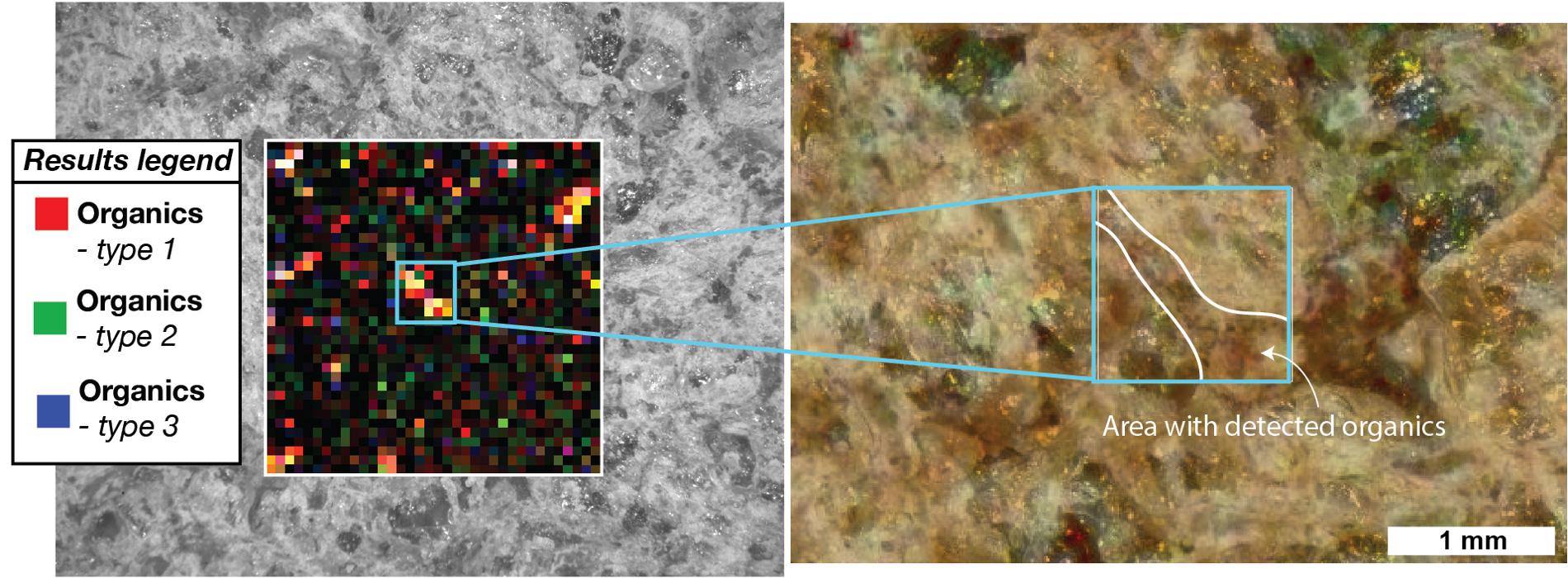SHERLOC’s View of Organics Within Garde Abrasion Patch
Caption:
Different kinds of carbon-based molecules called organic compounds were viewed within a rock target called "Garde" by SHERLOC, one of the instruments on the end of the robotic arm aboard NASA's Perseverance Mars rover. The rover used its drill to abrade, or grind away, a patch of rock so that SHERLOC (Scanning Habitable Environments with Raman & Luminescence for Organics & Chemicals) could analyze its interior. This data was taken on Sept. 18, 2021, the 207th Martian day, or sol, of the mission.
Nonbiological, geological processes can form organics. The organics found in PIXL's data and their association with the rocks that they're embedded within bear a striking resemblance to nonbiological organics within Martian meteorites, suggesting that these organics were formed by geological processes. Therefore, these organics findings are not biosignatures (compounds that indicate the presence of a biological process).
SHERLOC made the first detection of organics on the Martian surface since the Curiosity rover. It is also the first detection of organics on the Martian surface made through ultraviolet fluorescence spectroscopy (whereas the Curiosity rover utilized a different methodology known as mass spectrometry), and it is the first discovery of the spatial distribution of organics on the Martian surface. The organics were found to be simple aromatics present at low concentrations, which is similar to what was found by the Curiosity rover and within Martian meteorites.
Background Info:
A key objective for Perseverance's mission on Mars is
astrobiology
, including the search for signs of ancient microbial life. The rover will characterize the planet's geology and past climate, pave the way for human exploration of the Red Planet, and be the first mission to collect and cache Martian rock and regolith (broken rock and dust).
Subsequent NASA missions, in cooperation with ESA (European Space Agency), would send spacecraft to Mars to collect these sealed samples from the surface and return them to Earth for in-depth analysis.
The Mars 2020 Perseverance mission is part of NASA's Moon to Mars exploration approach, which includes
Artemis
missions to the Moon that will help prepare for human exploration of the Red Planet.
JPL, which is managed for NASA by Caltech in Pasadena, California, built and manages operations of the Perseverance rover.
For more about Perseverance:
mars.nasa.gov/mars2020
nasa.gov/perseverance
Cataloging Keywords:
| Name |
Value |
Additional Values |
| Target |
Mars |
|
| System |
|
|
| Target Type |
Planet |
|
| Mission |
Mars 2020 |
Mars Science Laboratory (MSL) |
| Instrument Host |
Perseverance |
Curiosity Rover |
| Host Type |
Rover |
|
| Instrument |
Scanning Habitable Environments with Raman & Luminescence for Organics and Chemicals (SHERLOC) |
|
| Detector |
|
|
| Extra Keywords |
Color, Dust, Moon, Ultraviolet |
| Acquisition Date |
|
| Release Date |
2021-12-16 |
| Date in Caption |
|
|
| Image Credit |
NASA/JPL-Caltech/MSSS/LANL/PhotonSys |
| Source |
photojournal.jpl.nasa.gov/catalog/PIA25042 |
| Identifier |
PIA25042 |

 Planetary Data System
Planetary Data System
